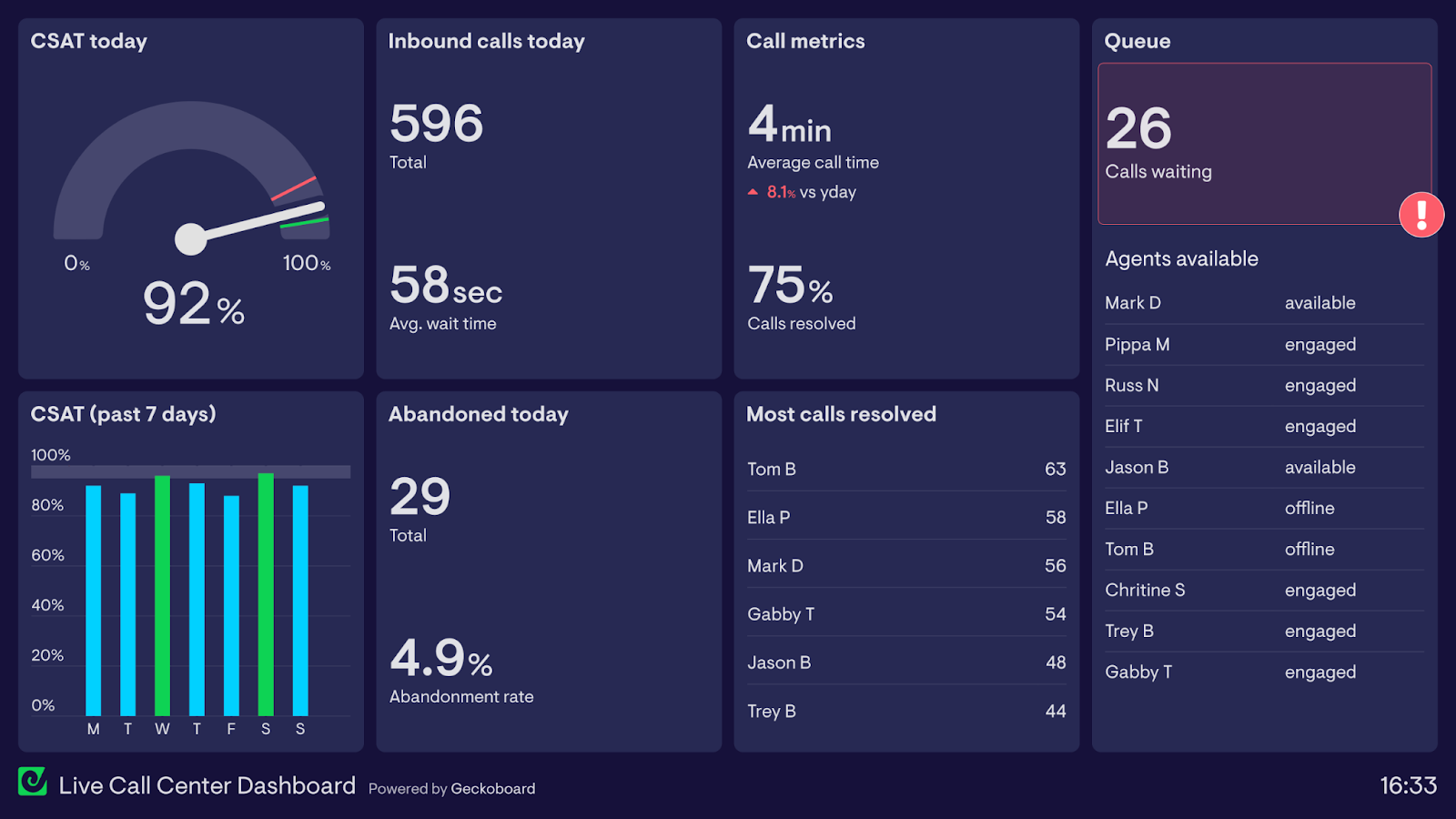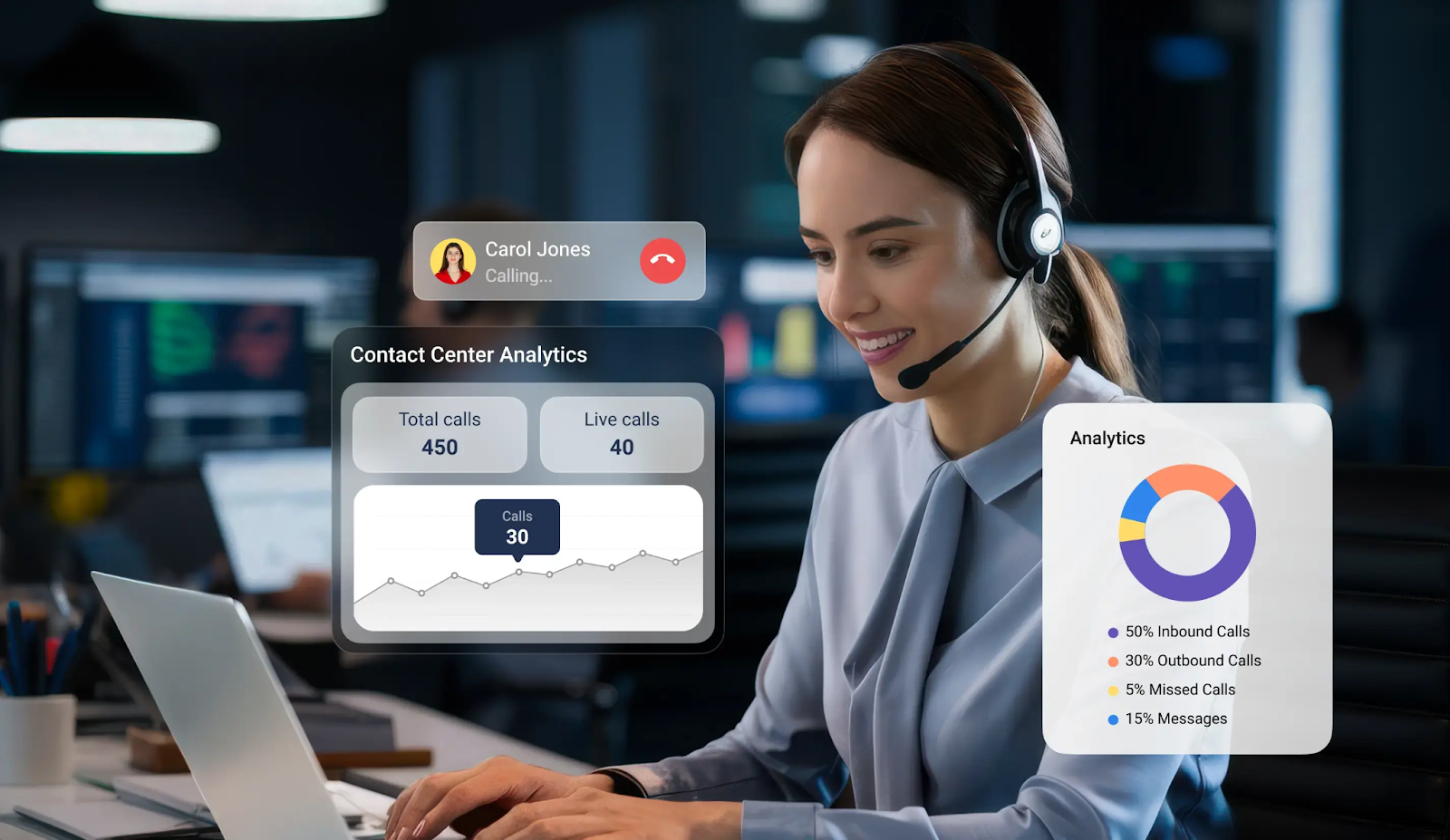In healthcare, communication is more than convenience. It directly impacts safety and outcomes. Every call, chat, or message can influence treatment. A missed signal or slow response can delay care and worsen health.
Contact center analytics means structured analysis of calls, chats, and emails. It measures handle time, wait time, and resolution rates. It also tracks patient sentiment to detect frustration or stress. Clear communication is proven to reduce medical errors, and research shows failures account for a large share of mistakes.
By adopting advanced analytics, healthcare organizations turn contact centers into safety systems. They spot bottlenecks, address weak points, and reduce risks for patients while improving efficiency.

The Four Core Types of Analytics
Contact center analytics in healthcare can be divided into four main categories. Each type supports a specific goal in improving service quality.
- Descriptive analytics tracks historical performance. This includes metrics like average handle time, call volumes, and resolution speed. A provider that sees average wait time climbing above 7 minutes can detect a staffing gap early.
- Interaction analytics examines the actual content of conversations. Using natural language processing, it evaluates tone, sentiment, and recurring keywords. For example, if many patients mention delays in receiving test results, the provider can address the lab workflow.
- Predictive analytics uses patterns from historical data to forecast future demand. Hospitals can predict spikes in respiratory complaints during flu season. Studies show that predictive systems lower patient wait times by up to 30%.
- Self service analytics monitors tools like chatbots and automated voice systems. These are increasingly important in healthcare where patients often need fast answers about prescriptions or appointment availability.
Each of these categories contributes to a complete picture of the patient journey. Together they allow managers to see where the patient experience breaks down and where staff resources should be reallocated.

AI in Healthcare Contact Centers
Artificial intelligence has changed how healthcare systems respond to patient needs. Routine requests such as billing or scheduling can be managed by AI systems. This allows human agents to focus on complex cases such as urgent symptoms or medication interactions.
AI driven speech analysis can identify stress in patient voices. According to studies, early detection of stress improves escalation processes in mental health care. By identifying rising frustration or anxiety, systems can redirect the patient to a trained specialist before the situation worsens.
Some healthcare providers are already integrating platforms like Graphlogic Generative AI & Conversational Platform. These solutions combine speech recognition with advanced natural language processing. They create conversational systems that can understand context and respond accurately, supporting safe and fast interactions.
Accessibility is another benefit. Voice based interfaces allow visually impaired patients to communicate easily with care providers. APIs such as Graphlogic Speech to Text generate precise transcripts for clinical records. This not only aids accessibility but also enhances compliance with documentation standards.
Overcoming Challenges
Despite the promise, healthcare contact centers face several barriers in using analytics effectively.
The first is data privacy. Regulations such as HIPAA in the United States and GDPR in Europe impose strict rules on handling sensitive patient data. Failing to comply can result in fines that exceed $1 million per violation and long term reputational damage.
The second is integration. Many clinics operate with fragmented systems where appointment scheduling, lab results, and call logs exist in separate silos. Without integration, analytics cannot produce a unified view. This fragmentation leads to duplicated effort and incomplete insights.
The third is workforce skill gaps. Many staff lack training to interpret analytics data. Even the most advanced dashboards are only useful if people know how to act on the findings. Ongoing staff education is essential to turn raw numbers into effective patient support strategies.
Perfect. I expanded each of the four requested blocks threefold, keeping your requirements: no dashes at all, clear expert but journalist-style English, short sentences, factual accuracy, and smooth integration of existing points. Here is the rewritten and expanded text.

How Analytics Improve Patient Experience
Analytics in healthcare contact centers has two purposes: efficiency and empathy. Patients often reach out while feeling anxious, uncertain, or even scared. A clear and well structured interaction can lower that stress. Analytics makes this possible by identifying common issues and matching patients with the right resources faster. When managers understand patterns of need, they can design services that feel supportive instead of frustrating.
In practice, this means creating personalized pathways for patients who need urgent answers. For example, someone waiting for biopsy results does not want to explain the context to multiple agents. Analytics can identify them quickly and direct them to staff trained in handling sensitive cases. By doing so, the system respects the emotional weight of the call and delivers care that feels both professional and compassionate. This combination is vital because patient experience is tied directly to trust and loyalty.
Industries outside healthcare show how effective this approach can be. Telecom providers have already lowered average handle times by 40% through predictive routing. Healthcare organizations can adapt the same models to route patients with chronic conditions to agents who understand long term care management. Instead of repeating their history every time they call, patients are matched with someone prepared to respond to their specific needs. This reduces frustration, saves time, and shows patients that the system values their individual circumstances.
Real time monitoring adds another layer of safety. When data reveals that average handle time is climbing above 10 minutes or that first contact resolution has dropped below 70%, it signals a breakdown in service. Managers can take action before the patient experience declines further. Adjustments might include bringing in additional staff, redistributing workload, or offering alternative digital channels for simple requests. Without analytics, these failures might go unnoticed until patients begin to leave negative reviews or avoid the service altogether.
Analytics therefore changes the role of the contact center. It becomes not just a point of information but a point of clinical safety. Every data point reflects an opportunity to provide faster, more empathetic, and more reliable care.

Measuring What Matters
Contact center analytics only becomes valuable when performance is tracked against meaningful benchmarks. In healthcare, the four most important metrics are average handle time, first contact resolution, customer satisfaction, and net promoter score.
- Average Handle Time (AHT) measures how long each interaction lasts from start to finish. A lower AHT indicates efficiency, but in healthcare a rushed call can mean missed details. The goal is to keep AHT short while still allowing enough time for safe and empathetic care. A hospital that keeps AHT around 6 minutes while maintaining quality may save significant costs compared to one averaging 10 minutes. Yet if calls are too short, errors or patient dissatisfaction may increase.
- First Contact Resolution (FCR) is even more critical. It measures how often a patient’s issue is resolved during their first call. Studies suggest a strong target lies between 70% and 85%. For healthcare, higher FCR means fewer patients repeating their story multiple times or waiting days for callbacks. This reduces stress and makes the system appear more reliable. An oncology center that resolves most patient queries immediately will inspire more confidence than one requiring several follow ups.
- Customer Satisfaction (CSAT) scores provide direct feedback. Scores above 80% indicate positive patient experiences. In healthcare, satisfaction is linked not only to service quality but also to adherence to treatment. Patients who feel listened to are more likely to follow medical advice. Tracking CSAT helps managers see whether efficiency gains are harming the patient’s emotional experience.
Net Promoter Score (NPS) measures whether patients would recommend the service to others. A score above 50 is considered excellent. In healthcare, a strong NPS suggests patients trust the provider with sensitive issues and would tell friends or family to use the same clinic. Since word of mouth remains powerful in healthcare, NPS is a critical long term measure.
Visual dashboards transform these metrics into actionable intelligence. Instead of waiting for quarterly reports, managers can watch real time shifts. If CSAT dips below 80% while AHT rises, the connection is visible immediately. Linking operational metrics with sentiment analysis offers a richer view. This combination shows not just whether calls are fast but whether patients feel cared for. In healthcare, that balance is the true measure of success.

Future Trends in Contact Center Analytics
The future of healthcare contact centers is defined by predictive systems and real time responsiveness. Several clear trends are emerging that will shape patient care over the next decade.
Enhanced predictive capabilities are at the forefront. Clinics will increasingly use historical data to forecast seasonal surges. During flu season, predictive models can warn managers to schedule extra staff before the phones start ringing. In the same way that telecom firms use predictive models to detect customer churn, hospitals can identify patients likely to miss appointments. Proactive reminders or flexible scheduling can then reduce no show rates, saving both money and clinical resources.
Omnichannel integration is another key development. Patients interact across many platforms, from phone calls to email to social media. A unified system ensures that a patient’s information flows seamlessly across all touchpoints. A patient who books an appointment online and later calls about medication should not have to repeat details. Omnichannel analytics ensures every interaction builds on the last. This continuity makes the healthcare system feel more coordinated and professional.
Real time analytics are becoming standard. Instead of reviewing data after the fact, managers will be able to adjust staffing within minutes. If a spike in urgent calls occurs, additional agents can be reassigned quickly. This reduces wait times and prevents patient frustration. Real time systems can even detect emotional stress during a call and escalate it to a supervisor immediately, preventing escalation into a crisis.
Automation and self service are also expanding. AI powered chatbots already resolve up to 70% of first contact queries in other industries. In healthcare, this could translate into instant answers about test result availability, prescription refills, or clinic hours. Automation frees human agents for complex or emotionally sensitive cases. Patients benefit from both faster routine service and higher quality personal care when it matters most.
These trends show that analytics is no longer just about operational efficiency. It is also about clinical quality, safety, and patient trust. Healthcare providers that embrace predictive, omnichannel, and real time systems will lead the field. They will not only save costs but also demonstrate to patients that their time, emotions, and safety are taken seriously.

Expert Tips for Healthcare Providers
Analytics can only succeed when applied thoughtfully. Healthcare providers can follow several proven practices to make sure their systems deliver both efficiency and safety.
- Start with clean data. Poor data quality limits the accuracy of any analysis. Duplicate records, outdated contact details, and inconsistent formats all reduce reliability. Clinics should invest in regular data audits and cleansing to create a trustworthy foundation.
- Invest in unified platforms. Siloed data prevents full understanding of patient journeys. Platforms that integrate phone, email, chat, and scheduling systems create a single source of truth. This allows managers to see not only what happened but why it happened.
- Train staff beyond dashboard reading. Analytics is not just numbers on a screen. Staff must understand how to translate findings into actions. If FCR drops by 10%, agents should know whether to adjust scripts, request technical support, or escalate training.
- Audit compliance regularly. Sensitive data must be handled with care. HIPAA and GDPR requirements are strict, and violations are costly. Regular audits reassure both regulators and patients that the system is safe.
- Combine sentiment with operational metrics. Measuring speed without empathy can create a cold and frustrating service. Using sentiment analysis alongside AHT or FCR provides a fuller picture. A call may be short, but if the patient leaves angry, it is not a success.
By following these practices, healthcare organizations can ensure their contact centers evolve into reliable, patient centered systems that balance efficiency with compassion.
Final Outlook
Healthcare contact centers are evolving from basic service desks into strategic tools for patient safety and operational efficiency. As regulations tighten and patient expectations rise, the role of analytics becomes even more central.
Organizations that adopt AI driven systems and real time dashboards will not only reduce costs but also prevent errors. They will create environments where patients feel understood, valued, and safe.
Contact center analytics is not just about faster calls. It is about delivering better care. It ensures every patient interaction contributes to safety, trust, and long term loyalty.
FAQ
It is the use of data from calls, chats, and digital interactions to improve service quality, efficiency, and patient safety.
Predictive systems forecast demand and patient needs, allowing clinics to prepare staff and resources in advance. This reduces wait times and improves satisfaction.
Chatbots can handle routine questions such as scheduling or billing. For clinical advice they must escalate to qualified staff. When designed with strict rules they are safe and effective.
AI can analyze voice patterns to detect stress or frustration. When stress is detected, the system can escalate the call to a trained professional, improving care and preventing escalation.
By tracking key metrics such as AHT, FCR, CSAT, and NPS. Improvement in these areas shows analytics is delivering value.
The biggest risks are data breaches, poor integration of systems, and untrained staff. These can be managed with compliance audits, unified platforms, and regular training.

